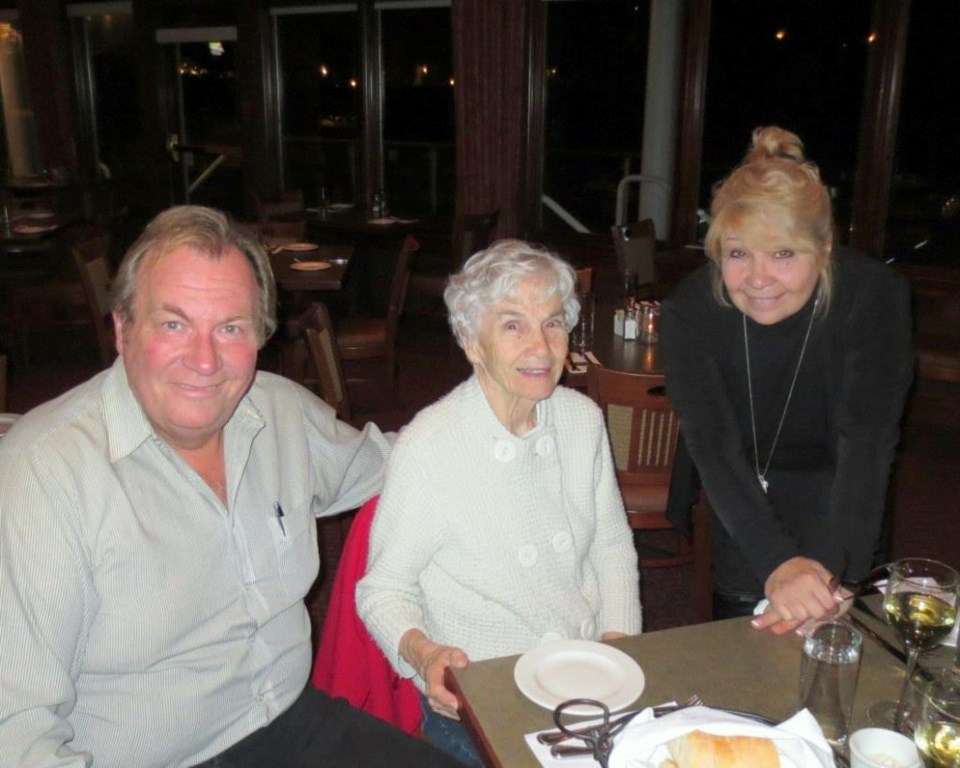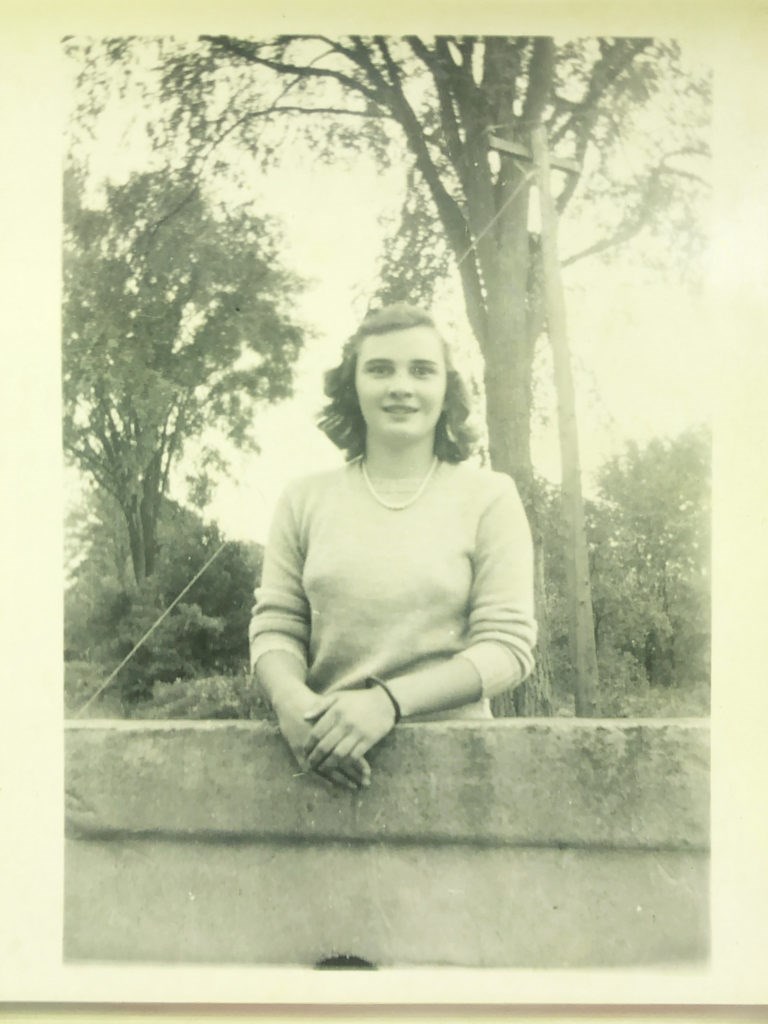
Golf Club. Photo supplied)
Joan Elliott was a Niagara-on-the-Lake woman who grew up on a family farm, but bridged the gap between life in the country and in the Old Town, with friends from both worlds.
She died Thursday, Jan. 14 at the age of 91 at Niagara Long Term Care Residence, formerly known as Chateau Gardens and Chartwell.
Her daughter, Jennifer Elliott, says her mother had been suffering from dementia for more than two years, “totally unaware” in recent months of COVID-19 and all that was going on around her, “and for that I’m thankful.”
Visiting had been a matter of sitting quietly holding her mother’s hand, but more recently, due to the pandemic, even that became difficult, with visitors having to be gloved, gowned and masked, says Jennifer.
Now in Florida, she says she was worried when she started to get emails from the administration at the home about the COVID outbreak, but her mother was in a private room, off by itself, and since Joan wasn’t mobile it was easy to keep her isolated. She did not have COVID, but started to fail quickly. “I’m glad it wasn’t COVID-related. I’m grateful for that, otherwise it would have been a much more difficult time for her.”
Her mother was born and raised in the historic brick farmhouse at Concession 2 near East and West Line, which many NOTLers would recognize as the former farm of John and Austin Kirkby, says Jennifer.
Joan was born a Cooper, a family that had been in Niagara since the 1700s, starting with crown land.
She had an older brother, Digby, and an older sister, Catherine, but one of the strong determining factors in her life was the death of Digby in the Second World War. Her brother would have inherited the farm, but instead it went to Kirkby, a cousin.
Digby’s loss “defined her as it did many of that generation,” says Jennifer.
Joan married John Elliott, a boy she had met at school, bringing two families with long histories in town together, although, Jennifer says, “the Elliotts don’t go as far back as the Coopers, but they both go back a long way.”
Although a rural girl, Joan’s father chose for her to go to schools in town, first in the elementary school that is now a bed and breakfast across from the NOTL Museum, and then to Niagara High School on Castelreagh Street, in a building that is now part of the museum itself.
Her mother would get a ride to school with Digby on his horse. “If he was in a good mood, he’d give his little sister a ride.”
On other days, they’d walk or ride their bikes, and some days her brother would carry her on his shoulders. “In winter, he’d put her on his shoulders to get them to school quicker, and she’d tell us she used her mittens to keep his ears warm. But he was 10 years older and she’d have to get off his shoulders when they got close to school so his friends wouldn’t see them.”
The Cooper farm had mixed crops, including Concorde grapes, peaches and pears, and vegetables, as well as pigs and chicken, says Jennifer. She remembers her mother talking about having to cut asparagus in the morning before breakfast, and getting ready for school.

“There was a lot to do on the farm, and she talked about that, but didn’t complain about it. A lot of her friends were doing the same thing, so it wasn’t an unusual situation.”
Jennifer’s father John worked for CIBC, at first on Queen Street in Niagara-on-the-Lake, and in those days, she said, the bank moved their employees around a lot, and expected them to take their family and become part of the community where they worked. The Elliotts moved to Niagara Falls, St. Catharines, and Vineland, with the farthest branch in London. John could have driven from their NOTL home to most of his job locations, but that wasn’t allowed.
Eventually, when he was close to retirement during the 1970s, he was brought back to the Queen Street branch. “The bank thought it was kind of a neat PR story, that he would end his career as a manager in the branch where he started.”
But NOTL “had never been out of our lives. Most, if not all weekends were spent in NOTL, with our families. It was always our home base, with both sets of grandparents, aunts and uncles and cousins on both sides of the family here in town.”
Joan dealt really well with the many moves, which were more upsetting for Jennifer and her brothers, she recalls, who were never thrilled to leave their friends and schools. Her mother, she says, “was quite the steady Eddy of the family, always concentrating on making us comfortable in our new homes. If she wasn’t happy, she wouldn’t have let it show.”
When they moved back to family and friends in NOTL, it was easier for both her parents to get involved in the community. They played golf at the NOTL Golf Course, and volunteered in the community, Joan chairing the fundraising committee for the big restoration of the Court House, John on the hospital board.
It was a time when tourism was taking hold, The Shaw Festival had opened, and the town was changing quickly. Joan and John lived on Regent Street, just off Queen Street, says Jennifer, “and they found it hard sometimes with swarms of people, and cars parked in front of their driveway. But they were good at accepting the changes, and saw the good and the bad as the town moved forward.”
Jennifer at that time was living in Montreal, but moved back to town, and says she got to know her parents better than she had in the earlier years. “We had great times together, and really enjoyed our NOTL life together. They were great years.”
St. Andrew’s Presbyterian Church was always a big part of her parents’ life from the Elliott side of the family, although, Jennifer says, it was one of her great grandfathers — she’s not sure how many ‘greats’ he goes back— on the Cooper side, James Cooper, who designed the front of St. Andrew’s in 1831.
Looking back, Jennifer remembers her mother as “loving, creative, and very intelligent. She was a really smart lady.”
In her 40s, Joan, who had usually had a part-time job, typically at a nursery school, decided to go to Brock University, and received a bachelor of arts in early childhood education.
She worked for the region at various day care centres, and eventually got into administration, pioneering the region’s private day care program.
“By then I was in high school, and she was a full-time working mom. She was a great, loving mom who did all the typical things moms did, but she was atypical in the other things she enjoyed doing.”
In her 60s, Joan wrote two books, one called The Quilt, which Jennifer describes as “a patchwork of family history, covering the Elliott and Cooper sides, from the childhoods of my grandparents to modern times, and about growing up in town.” In the introduction, she says she wrote it for her children and grandchildren so that they might learn about their ancestors and the events that shaped them, and writes that “in the years to come, new information can be added to this history, providing new colour, pattern and dimension to the quilt.” The museum keeps a copy of The Quilt for reference.
The other is a compilation of her brother’s letters home when he was in the air force, and her thoughts and recollections of those days, says Jennifer.
“I like to bring them away with me and reread the stories, but I didn’t this year. I wish I had them with me now,” she says.
Jennifer is in Florida, where she and her husband Colin Telfer, are spending the winter, “hunkering down.”
She and the rest of the family have decided that with COVID regulations, they will try to plan a celebration of life when they can all be together in the summer.